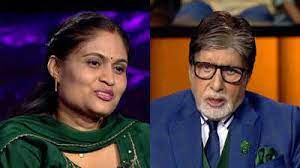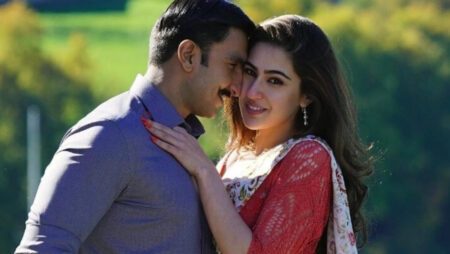On Wednesday, Dharma Productions unveiled the trailer for Meenakshi Sundareshwar, but not everyone is pleased with it.
Bollywood has a knack for upholding age-old stereotypes rather than letting them down and do better. In that trend, ‘Meenakshi Sundareshwar,’ starring Sanya Malhotra and Abhimanyu Dassani, is the most recent film from Netflix to draw public ire.
Netizens flocked to Twitter as soon as the trailer was published to express their disgust with the film’s stereotyping of Tamil culture and inclusion of references to Rajinikanth, among other things.
‘Meenakshi Sundareshwar,’ produced by Karan Johar and directed by Vivek Soni, is ostensibly about a long-distance relationship where the pair discovers love in an arranged marriage.
The teaser showed the ‘Chettiar’ wedding being true to the region, as part of the Madurai and the nearby are Chettiars and also let their lead actors retain their original accent.
Still, the teaser is tainted when the actors portray stereotypical circumstances we’ve seen a thousand times before, including the Thalaiva link. It signals familiarity yet so alien.
Stereotyping in Bollywood
Tamilians are fed up with Bollywood’s attempts to box them into the same stale categories and have taken to social media to point out the problems.
People had to say that Tamil women do not spend their days wearing jasmine flowers, jhumkis, bangles, and half-saris. They don’t need to ‘dress’ in ‘Tamil Nadu’ because they live there, and the plot should be compelling enough to justify the culture.
They implore to stop bringing up Rajinikanth reference; not every South Indian is enamored with him. Characters having Marathi, Punjabi, Haryanvi, Bengali, or Goan descent are all stereotyped in the same way. It doesn’t stop with the random use of “agga bai,” “balle balle,” and “ich” in every sentence.
For example, any Punjabi persona on TV must be accompanied by happy Punjabi music, since else, how would the viewers learn about their roots? Goans are often stereotyped as slackers who either drink or sleep.
The open letter
In an open letter to Netflix India, Architectural Designer Adhavan Sundaramurthy on stereotyping and representation. He wrote that he lauds Netflix for an amazing platform. He sees that as the power to bring social change.
He appreciates efforts in including Tamil culture as a part of the narrative but states that Tamilians across the globe are already dealing with enough stereotyping, misrepresentation, and skewed narratives.
He continues that as an artist, a designer, and a person from the Tamil Diaspora, having experienced these issues first hand, he says that it’s difficult to fight the stereotype and misrepresentation to create a space for oneself in society.
He added, “If you can’t help us, it’s okay. But don’t make it worse for us. Remember “Lungi Dance/ Chennai Express”? Just for the records, it’s been eight years since the release. Trust me, and we’re still recovering from the damages it made.
I didn’t say RECOVERED but RECOVERING. And here you are with Meenakshi Sundareshwar.
“There’s a difference between being a voice and providing a platform. He said that Tamilians don’t need a voice cause they have amazing creators and storytellers in Tamil Nadu and across the globe. Need of the day is a platform, and Netflix already provides it. With the platform, let Tamilians tell their stories because Tamil culture is not just about “songs with Rainikanth dialogues as lyrics” or “Thalaiva in the chorus” or “including Rajinikanth (or Superstar Rajinikanth) references” but beyond that.
Do it right or don’t do it
When Meenakshi Sundareshwar showcases Madurai, he pinpoints the blunders. He says many differences between Madurai, Coimbatore, and Chennai, be it the slang, tradition, or cultural practices.
Akhavan brings the example of veteran director Vetrimaran, who knows a lot more about Tamil culture than the entire Bollywood put together but had to have a local from Madurai in his team to be true to the slang and characteristics while making Aadukalam.
He questions, “How many people from Madurai or at least from Tamil Nadu or just Tamil people, in general, did you have in your creative team for Meenakshi Sundareshwar? Either I barely see anyone, or the IMDB list is lying”.
The architectural designer emphasizes that he is not trying to stop making movies or series based on Tamil culture in Hindi because he also believes in an inclusive society.
But he doesn’t want another “Bollywoodsplaining” of not just Tamil culture but any culture for that matter. He says, “Either do it right, or please don’t do it at all.”
Let’s be inclusive
When movies showcase the best of our culture by taking a pragmatic view through a well-trained lens, it elicits a sense of nostalgia and makes it relatable for the public.
However, the opposite occurs when a film stereotypes characters or patronizes them.
In current times where language is no more a hurdle to watching shows and movies – from Squid Game to Money Heist-, the world has fallen in love with them.
Let’s accept that Tamilians don’t speak Hindi and create an extraordinary love tale in the language spoken in these homes, with people familiar with the culture.
Instead of jeopardizing the integrity of an entire state, we can use subtitles.












